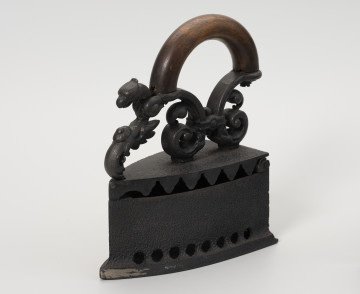
Iron stand
1890 — 1910
National Museum in Szczecin
Part of the collection: Everyday life in the Polish People's Republic
Traditionally, a washtub filled with warm water was prepared before a washboard was used. Dirty clothes were immersed in the water to be soaked, and then the washboard was attached to the wall of the tub using pegs. The soaped fabrics were rubbed against the corrugated surface. After the material was cleaned, it was transferred to a separate vessel with fresh water and rinsed to remove any foam. Initially, they were made entirely of wood, then the corrugated part of the washboards began to be produced in the form of rolled sheets, then porcelain, and in the 20th century also from marble and glass. The change in material was intended to protect the fabrics from damage. Wooden and tin boards in particular caused the fibres to pull when rubbed. At the Poznań International Fair in 1962, these glass products were presented as an excellent industrial achievement. Their quality was emphasized – the smooth surface of the glass did not cause damage to fabrics. This, probably 18th-century Scandinavian invention, reduced the amount of time spent on washing by hand or using washing paddles. It also allowed to transfer the entire process from rivers or other water reservoirs to the interior of households. The prevalence of washboards dates back to the 19th century – they were then as popular in Europe as in the United States. In Poland, at the beginning of the 20th century, washboards were called "hand notched machines". In the first post-war years, they were certainly in common use, especially in villages - because they did not require electricity. In 1950 only about 20% of Polish farms were electrified, and in the second half of the 1960s – about 85%. The decline of the use of washboards in homes can be considered in the 1960s, when they began to be replaced by washing machines. Only the latter significantly shortened the washing time and ended the period in history when it required a lot of physical strength. In Poland, the devices that replaced the washboards were the "Frania" rotary washing machines. Paula Sendra
Author / creator
Object type
washboard (laundry)
Technique
rolling, cutting, assembling
Material
glass, wood
Origin / acquisition method
donation
Creation time / dating
Owner
Muzeum Narodowe w Szczecinie
Identification number
Location / status

1890 — 1910
National Museum in Szczecin

1901 — 1939
National Museum in Szczecin

1851 — 1900
National Museum in Szczecin
DISCOVER this TOPIC
National Museum in Szczecin
DISCOVER this PATH
Educational path